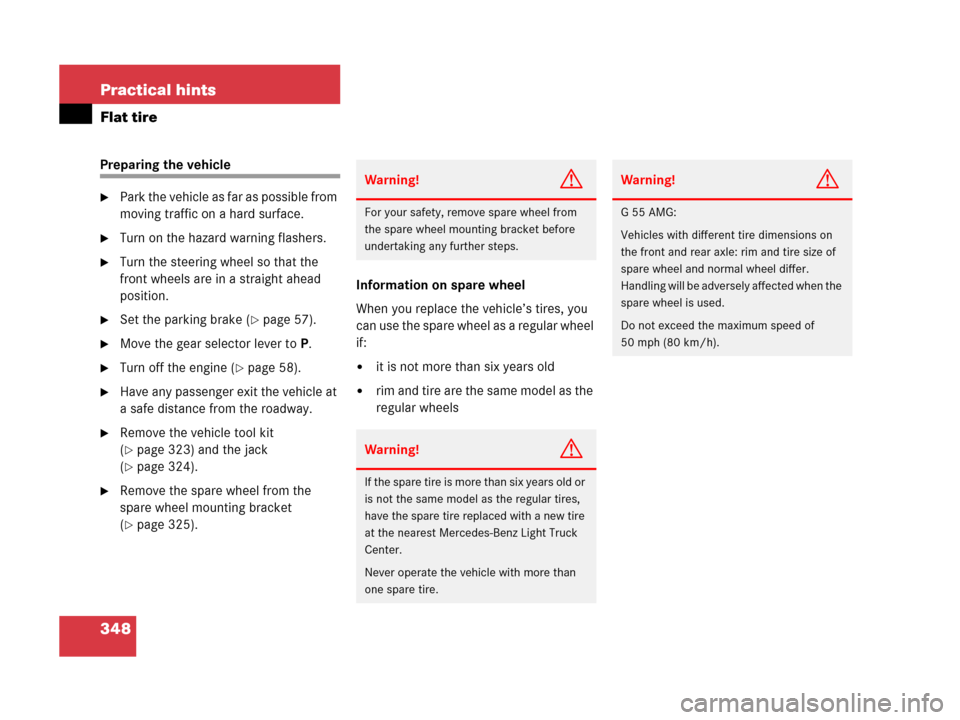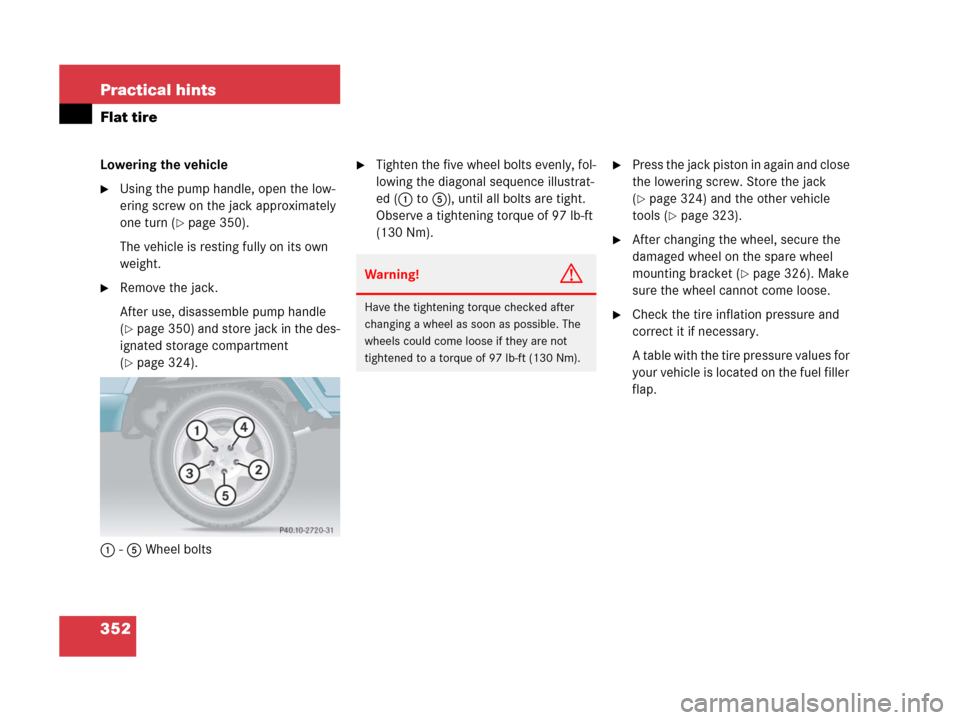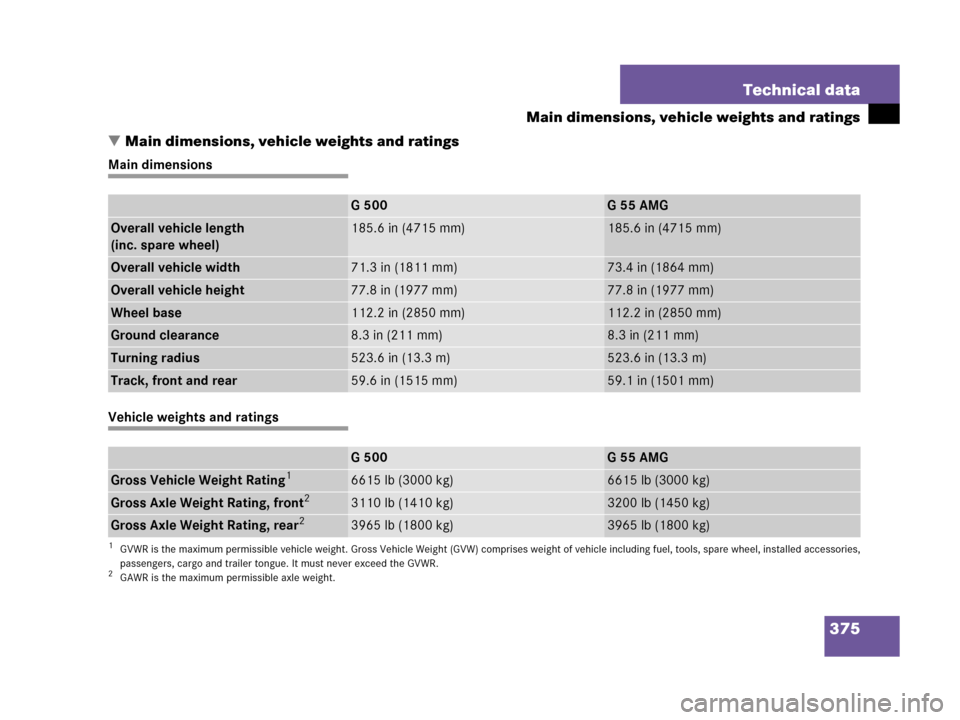Page 280 of 417

279 Operation
Winter driving
Block heater (Canada only)
The engine is equipped with a block
heater.
The electrical cable may be installed at an
authorized Mercedes-Benz Light Truck
Center.
Snow chains
Snow chains should only be driven on
snow-covered roads at speeds not to
exceed 30 mph (50 km/h). Remove chains
as soon as possible when driving on roads
without snow.Please observe the following guidelines
when using snow chains:
�Use of snow chains is not permissible
with all wheel/tire combinations.
�Snow chains should only be used on
the rear wheels. Follow the manufac-
turer’s mounting instructions.
�Only use snow chains that are
approved by Mercedes-Benz. Your
authorized Mercedes-Benz Light Truck
Center will be glad to advise you on this
subject.
�Use of snow chains may be prohibited
depending on location. Always check
local and state laws before installing
snow chains.
Warning!G
If you use your spare tire when winter tires
are fitted on the other wheels, be aware that
the difference in tire characteristics may
very well impair turning stability and that
overall driving stability may be reduced.
Adapt your driving style accordingly.
Have the spare tire replaced with a winter
tire at the nearest authorized
Mercedes-Benz Light Truck Center.
i
When driving with snow chains, you
may wish to deactivate the ESP
(
�page 84) before setting the vehicle
in motion. This will improve the
vehicle’s traction.
Page 326 of 417
325 Practical hints
Where will I find...?
Spare wheel
The spare wheel is located under a cover
on the outside of the vehicle’s tailgate.
For information on rim and tire specifica-
tions, see (
�page 371) and (�page 373).
Removing cover
1Cover ring
2Key
3Tab
�Open lock for cover ring1 with
key2 for the spare wheel cover.
�Fold tab3 downwards.
4Cover plate
�Pull cover ring1 slightly outwards in
direction of arrows and remove.
�Pull cover plate4 upward towards
you.5Catch
6Recess
i
When replacing cover plate4, make
sure catch5 engages in recess6.
Make sure the lock faces downwards
when mounting cover ring1.
For safety reasons, check regularly that
the spare wheel is securely fastened.
Page 327 of 417
326 Practical hints
Where will I find...?
Removing the spare wheel
1Mounting screws
�Unscrew mounting screws1.
�Remove the spare wheel.For more information on changing the
wheel, see “Flat tire” (
�page 348).
Warning!G
Make sure no one is injured when removing
the spare wheel.
Grip wheel from the sides.
Keep hands from beneath the wheel.
i
After changing the wheel, secure the
replaced wheel on the spare wheel car-
rier. Make sure the wheel cannot come
loose.
Cover the wheel with the cover plate.
Repair or replace damaged tire as soon
as possible and return spare tire as
original spare.
Page 349 of 417

348 Practical hints
Flat tire
Preparing the vehicle
�Park the vehicle as far as possible from
moving traffic on a hard surface.
�Turn on the hazard warning flashers.
�Turn the steering wheel so that the
front wheels are in a straight ahead
position.
�Set the parking brake (�page 57).
�Move the gear selector lever toP.
�Turn off the engine (�page 58).
�Have any passenger exit the vehicle at
a safe distance from the roadway.
�Remove the vehicle tool kit
(
�page 323) and the jack
(
�page 324).
�Remove the spare wheel from the
spare wheel mounting bracket
(
�page 325).Information on spare wheel
When you replace the vehicle’s tires, you
can use the spare wheel as a regular wheel
if:
�it is not more than six years old
�rim and tire are the same model as the
regular wheels
Warning!G
For your safety, remove spare wheel from
the spare wheel mounting bracket before
undertaking any further steps.
Warning!G
If the spare tire is more than six years old or
is not the same model as the regular tires,
have the spare tire replaced with a new tire
at the nearest Mercedes-Benz Light Truck
Center.
Never operate the vehicle with more than
one spare tire.
Warning!G
G55AMG:
Vehicles with different tire dimensions on
the front and rear axle: rim and tire size of
spare wheel and normal wheel differ.
Handling will be adversely affected when the
spare wheel is used.
Do not exceed the maximum speed of
50 mph (80 km/h).
Page 350 of 417

349 Practical hints
Flat tire
Mounting the spare wheel
�Prepare the vehicle (�page 348).
Lifting the vehicle
�Prevent the vehicle from rolling away
by blocking wheels with wheel chocks
(not included) or other sizable objects.
When changing wheel on a level surface:
�Place one chock in front of and one be-
hind the wheel that is diagonally oppo-
site to the wheel being changed.
Always try lifting the vehicle using the jack
on a level surface. However, should cir-
cumstances require you to do so on a hill,
place the wheel chocks as follows:
�Place chocks on the downhill side
blocking both wheels of the axle not
being worked on.
Wheel wrench
�On wheel to be changed, loosen but do
not yet remove the wheel bolts (ap-
proximately one full turn with wrench).
Warning!G
The jack is designed exclusively for jacking
up the vehicle under the axle housing. To
help avoid personal injury, use the jack only
to lift the vehicle during a wheel change.
Never get beneath the vehicle while it is sup-
ported by the jack. Keep hands and feet
away from the area under the lifted vehicle.
Always firmly set parking brake and block
wheels before raising vehicle with jack.
Do not disengage parking brake while the
vehicle is raised. Be certain that the jack is
always vertical (plumb line) when in use, es-
pecially on hills. Always try to use the jack
on level surface. Make sure the jack is posi-
tioned correctly under the axle housing. Al-
ways lower the vehicle onto sufficient
capacity jackstands before working under
the vehicle.
If the vehicle is not raised as described, it
could slip off the jack as a result of vibra-
tions (e.g. opening or closing a door or the
tailgate).
Page 353 of 417

352 Practical hints
Flat tire
Lowering the vehicle
�Using the pump handle, open the low-
ering screw on the jack approximately
one turn (
�page 350).
The vehicle is resting fully on its own
weight.
�Remove the jack.
After use, disassemble pump handle
(
�page 350) and store jack in the des-
ignated storage compartment
(
�page 324).
1-5 Wheel bolts
�Tighten the five wheel bolts evenly, fol-
lowing the diagonal sequence illustrat-
ed (1 to 5), until all bolts are tight.
Observe a tightening torque of 97 lb-ft
(130 Nm).�Press the jack piston in again and close
the lowering screw. Store the jack
(
�page 324) and the other vehicle
tools (
�page 323).
�After changing the wheel, secure the
damaged wheel on the spare wheel
mounting bracket (
�page 326). Make
sure the wheel cannot come loose.
�Check the tire inflation pressure and
correct it if necessary.
A table with the tire pressure values for
your vehicle is located on the fuel filler
flap.
Warning!G
Have the tightening torque checked after
changing a wheel as soon as possible. The
wheels could come loose if they are not
tightened to a torque of 97 lb-ft (130 Nm).
Page 374 of 417
373 Technical data
Rims and tires
Spare wheels
G500G55AMG
Rims (light alloy)71/2 J x18 H271/2 J x18 H2
Wheel offset1.69 in (43 mm)1.69 in (43 mm)
All season tires (radial-ply tires)265/60 R18 110V M+S265/60 R18 110V M+S
Page 376 of 417

375 Technical data
Main dimensions, vehicle weights and ratings
�Main dimensions, vehicle weights and ratings
Main dimensions
Vehicle weights and ratings
G500G55AMG
Overall vehicle length
(inc. spare wheel)185.6 in (4715 mm)185.6 in (4715 mm)
Overall vehicle width71.3 in (1811 mm)73.4 in (1864 mm)
Overall vehicle height77.8 in (1977 mm)77.8 in (1977 mm)
Wheel base112.2 in (2850 mm)112.2 in (2850 mm)
Ground clearance8.3 in (211 mm)8.3 in (211 mm)
Turning radius523.6 in (13.3 m)523.6 in (13.3 m)
Track, front and rear59.6 in (1515 mm)59.1 in (1501 mm)
G500G55AMG
Gross Vehicle Weight Rating1
1GVWR is the maximum permissible vehicle weight. Gross Vehicle Weight (GVW) comprises weight of vehicle including fuel, tools, spare wheel, installed accessories,
passengers, cargo and trailer tongue. It must never exceed the GVWR.
6615 lb (3000 kg)6615 lb (3000 kg)
Gross Axle Weight Rating, front2
2GAWR is the maximum permissible axle weight.
3110 lb (1410 kg)3200 lb (1450 kg)
Gross Axle Weight Rating, rear23965 lb (1800 kg)3965 lb (1800 kg)